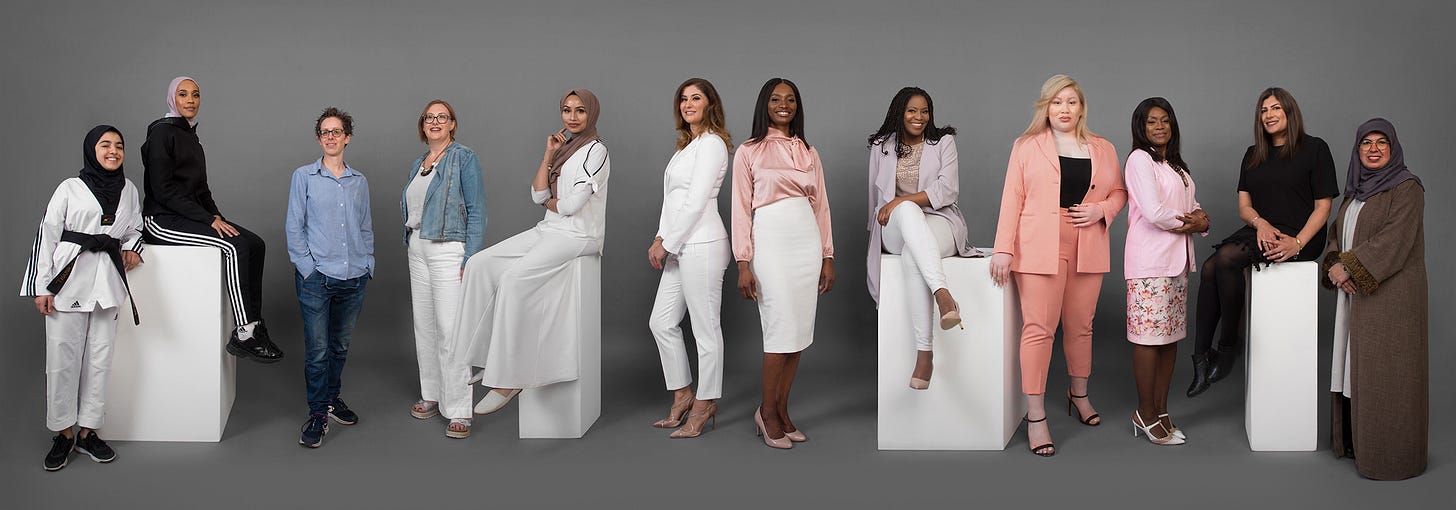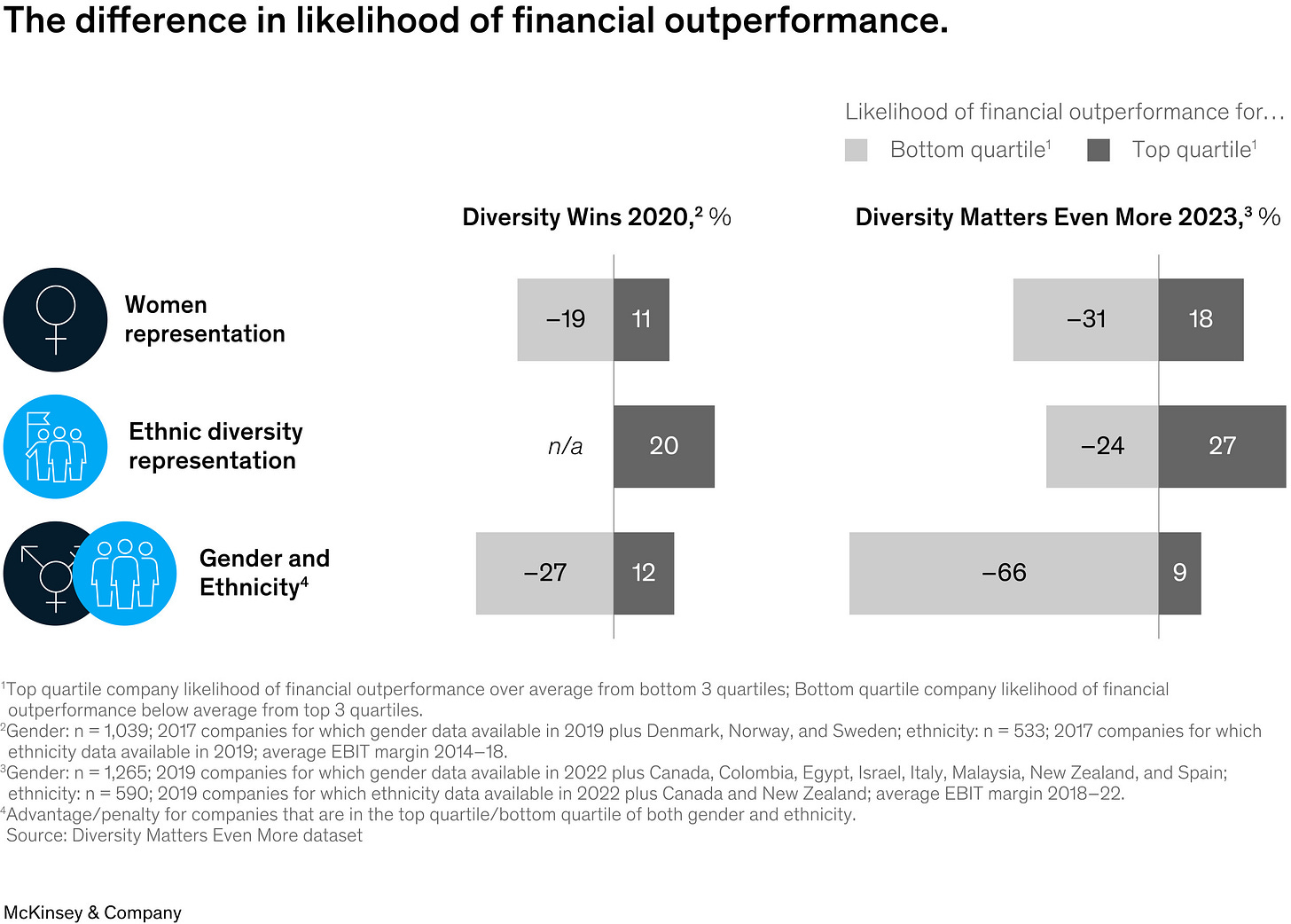Women(+)'s Day Special : The "Diversity, Equity and Inclusivity" Issue
As we celebrate female entrepreneurs leading the charge for a more holistic landscape that celebrates all genders and body types, the industry must dismantle more nuanced biases for true inclusivity

“We will all profit from a more diverse, inclusive society, understanding, accommodating, even celebrating our differences, while pulling together for the common good.”
–Ruth Bader Ginsburg
Justice Ginsburg, the Notorious RBG, the OG queen of equality, #woke before her time, the baddest bad a** ever and one of my absolute idols - perfectly captured the essence of why diversity, equity and inclusion are not just the right thing to do, but also a recipe for success. If we forget all else - we can use pure economics and mathematics to be profitable in no matter which industry we operate in. We just have to be more inclusive, create more equal opportunities and be cognisant of diverse voices.
Creating multiple positive impacts with a sound DEI Policy
(TL;DR - If you’re tone-deaf, you’ll be booking losses- in life as in business)
A DEI (Diversity, Equity, and Inclusion) policy for a fashion entrepreneur outlines a commitment to fairness and representation throughout the business. It is a very minutely crafted and tangible roadmap which translates to actions such as - actively seeking diverse talent within the company, ensuring fair treatment and opportunities for all employees, and offering products that cater to a wide range of body types, ethnicities, and gender identities. Essentially, a DEI policy ensures your brand reflects the world you live in, both internally and externally.
What RBG said long ago is backed by solid research today. A periodic report by McKinsey & Company published in November 2023, is aptly titled “Diversity Matters Even More : The case for holistic impact”. This is the fourth report in a McKinsey series investigating the business case for diversity, following Why Diversity Matters (2015), Delivering Through Diversity (2018), and Diversity Wins (2020). These reports deliver a comprehensive global perspective on the relationship between leadership diversity and company performance.
Above is a visual depiction of one of their key findings. The report states that companies with representation of women exceeding 30 percent (and thus in the top quartile) are significantly more likely to financially outperform those with 30 percent or fewer. Similarly, companies in the top quartile for ethnic diversity show an average 27 percent financial advantage over others. Both forms of diversity in executive teams appear to show an increased likelihood of above-average profitability.
More interestingly the report points to the fact that companies with greater diversity on their boards of directors are more likely to outperform financially. For the first time this correlation is statistically significant for both gender and ethnicity. It clearly states that companies in the top quartile for board-gender diversity are 27 percent more likely to outperform financially than those in the bottom quartile. Similarly, companies in the top quartile for ethnically diverse boards are 13 percent more likely to outperform than those in the bottom quartile. These findings support the hypothesis that diversity benefits extend across top corporate leadership to boards, where DEI policy decisions for the whole organisation are often made.
As a fashion entrepreneur, building a brand that reflects the world's richness – different ethnicities, body types, genders, and sexualities – isn't just woke, it's strategic as it has a direct impact on one’s DEI policy. It allows you to connect with a wider audience, tap into a growing market segment that values authenticity, and build a loyal customer base that feels seen and celebrated. In simpler terms, by embracing everyone's unique style and story, you're creating a win-win situation for your brand and society as a whole. Marry it with legal compliance and regulation - you make a positive impact by championing the Changemaker’s Equation.
A sound DEI policy in fashion entrepreneurship goes beyond just optics. It creates a ripple effect of positive social, cultural, and environmental impact.
- Socially, it fosters a more welcoming and collaborative work environment, attracting and retaining talent from diverse backgrounds. This leads to a richer pool of ideas and perspectives, ultimately resulting in more innovative and culturally relevant designs.
- Culturally, a DEI policy promotes respect and appreciation for different ethnicities, body types, and gender identities. By catering to a wider audience, brands empower individuals to express themselves authentically and challenge outdated beauty standards.
- Environmentally, a well-crafted DEI policy often fosters a culture of ethical sourcing and mindful production. Diverse teams are more likely to identify opportunities for sustainable materials, size inclusivity to reduce textile waste, and fair labor practices throughout the supply chain. In essence, a strong DEI policy doesn't just benefit the brand; it empowers employees, celebrates diverse cultures, and paves the way for a more responsible and sustainable fashion industry.
A legacy of exclusion and the "Male Gaze"
The fashion industry's struggle with diversity and inclusion is deeply rooted. For decades, the "male gaze" dominated fashion, dictating what was considered beautiful and desirable. This resulted in a singular focus on Eurocentric features and slim body types, leaving a vast majority of the population feeling unseen and unrepresented. Statistics paint a stark picture. A 2015 study by the Business of Fashion revealed that upon analysing a representative sample of catwalk shows they discovered that out of nearly four thousand models, only 800 were non-white models. Further, a 2017 study by The Fashion Spot examined 94 major New York shows and tallying 2,601 runway appearances, to find that 63.1 percent of castings were white and 36.9 percent were non-white. Although the figures show improvement today, this lack of representation not only sends a message of exclusion but also reinforces unrealistic beauty standards that can have a negative impact on mental health, particularly among young people.
Furthermore, the industry's lack of size inclusivity has historically marginalised people of all genders who don't conform to narrow body ideals. A 2020 report by the National Eating Disorders Association, titled The Social and Economic Cost of Eating Disorders in the United States of America: A Report for the Strategic Training Initiative for the Prevention of Eating Disorders and the Academy for Eating Disorder revealed that 9% of the US population, or 28.8 million Americans will have an eating disorder in their lifetime. And there is a huge possibility that is fueled by societal pressure to conform to unrealistic body image portrayals.
The tech bias spillover
The rise of tech-enabled entrepreneurship in fashion offers both possibilities and challenges. While technology has undoubtedly lowered barriers to entry, allowing diverse voices to emerge, these new ventures can sometimes unwittingly replicate the biases present in the tech sector itself. Algorithms used in design software or online marketing platforms can perpetuate existing biases, limiting the range of styles and models presented to consumers. For example, an algorithm trained on a dataset of predominantly white models might struggle to accurately represent the diversity of skin tones and body shapes, leading to a skewed perception of beauty and further marginalising certain communities. Entrepreneurs in fashion-tech need to be particularly aware of these potential biases and actively work to ensure their algorithms and practices promote inclusivity.
Shattering the glass ceiling and redefining narratives
Fortunately, a new wave of entrepreneurs is breaking down these barriers and reshaping the fashion landscape. Emma Grede, a Black female entrepreneur, Founding Partner, SKIMS, Co-Founder, Safely, Chairwoman, Fifteen Percent Pledge, CEO and Co-Founder, Good American, a clothing line that celebrates size-inclusivity and body-positivity. By offering a wider range of sizes and celebrating diverse body types, Grede is not only empowering individuals but also challenging the industry's narrow definition of beauty. Her success story demonstrates the growing demand for inclusivity and the potential for brands that embrace diverse narratives to thrive.
Celebrating Global Voices
Moving beyond the western world, India's Anita Dongre, with her eponymous label House of Anita Dongre, has consistently pushed boundaries with her fusion of traditional Indian textiles and contemporary silhouettes. Her designs showcase cultural diversity on a global stage, reminding us that fashion is not a monolith but a vibrant dialogue between different aesthetics and traditions. She is deeply committed to sustainability, animal welfare and women empowerment and gives her time and energy to promoting awareness about the issues she believes in.
Similarly, Christine Centenera, an Australian-born Filipina stylist and founder of her label Wardrobe NYC, is another inspiring figure who breaks down barriers with her role of Editor-in-Chief at Vogue Australia. She is lauded for creating gender-fluid designs, challenging traditional notions of masculinity and femininity. Centenera's work demonstrates that fashion can be a powerful tool for self-expression, unbound by rigid categories.
Beyond Representation
The fight for diversity and inclusion goes beyond representation on runways and magazine covers. It encompasses ethical production practices, fair wages throughout the supply chain, and a commitment to sustainability.
LGBTQIA+ entrepreneur Riccardo Tisci, the former creative director of Givenchy and Burberry, has used his platform to champion inclusivity. His high-fashion collections redefine traditional notions of beauty and celebrate diversity while adhering to practices that create a positive impact.
Catering to and collaborating with Gen Z
The fashion anthropology has explored issues arising from exclusivity and Eurocentric beauty standards within the industry for years. It is certainly undergoing a seismic shift towards greater diversity and inclusion. While the runway lights have traditionally illuminated a narrow spectrum of models and the racks held limited size options, a powerful force for change is surely emerging.
Roberta Katz, an anthropologist at Stanford’s Center for Advanced Study in the Behavioral Sciences (CASBS) recognises through her research that though consumers have rewarded greater authenticity online for some time, it is becoming more pronounced as influencers emphasise their individuality. Generation Z – also known as Gen Z, iGen or postmillennial – are a highly collaborative cohort that cares deeply about others and have a pragmatic attitude about how to address a set of inherited issues like climate change, according to research. While pursuing their own identity and embracing their individuality Gen Z consumers are demanding authenticity and representation. They want fashion to reflect the vibrant tapestry of our world, not perpetuate outdated ideals. This shift is driven by a growing awareness of the industry's shortcomings and the potential for positive change.
Her advice for those who are now with Gen Zers in the workplace, is to recognize that these new colleagues are used to working collaboratively and flexibly, with an eye to being efficient in getting the job done. They are pragmatic and value direct communication, authenticity and relevance.
Women(+)’s Day : A day to celebrate “force for good”
As important as it is to celebrate women not just for a day, but through the year, let this International Women's Day be a celebration of the inherent strength and positive influence every single person possesses, irrespective of the gender.
We must acknowledge the historical struggles for women's rights while recognising the power of feminine energy, naari shakti, that uplifts and empowers all gender to do their bit towards a more equitable future. Let's honor the achievements of women and use this day to inspire everyone to be a force for good in the world.
We admire the journeys of all the entrepreneurs, who are working towards a more inclusive and sustainable fashion industry. They understand that true progress involves not just offering a wider range of sizes or featuring diverse models, but also ensuring fair wages throughout the supply chain, minimising environmental impact, and respecting the dignity of all people involved in the industry.
Their narratives go beyond representation; they weave together climate consciousness, social impact, and ethical practices. - And we are here for each one them.
Dedication : To Strong Women. May we know them. May we be them. May we raise them.





